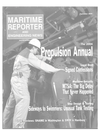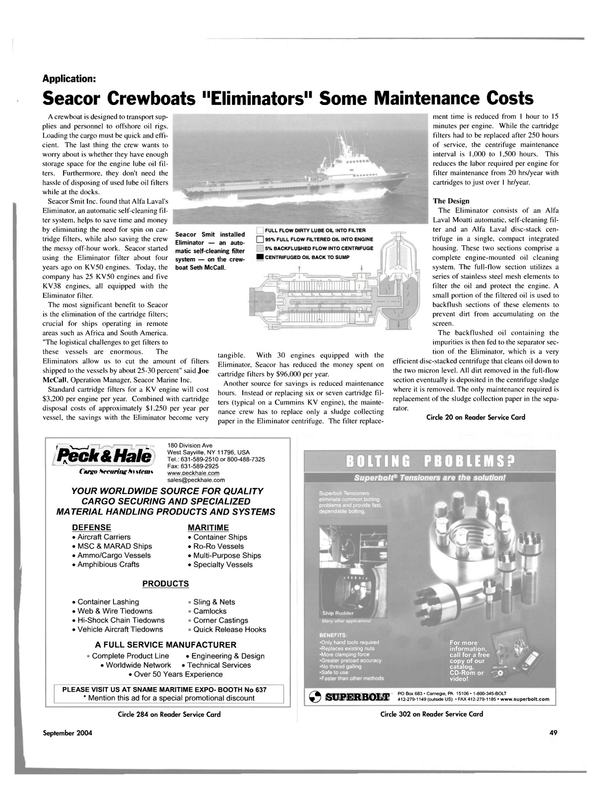
(Fuel) Cells of Endeavor
German industry is doing much to advance the development and application of fuel cell technology, and is responsible for many of the initiatives launched so far in the marine sector.
Although skeptics in the commercial shipping domain discount the chances of a substantial uptake of fuel cell power aboard mercantile traders in the foreseeable future, there is a growing realization of the long-term possibilities offered by the technology, albeit in specialized areas. Use in auxiliary plant may hold out certain opportunities in some types of vessel.
Minimal environmental impact, due to an absence of the noxious emissions produced by internal combustion engines, plus quiet, vibration-free running and high thermal efficiency are characteristics of fuel cells that are of interest to sectors of the marine market.
In the meantime, Howaldtswerke- Deutsche Werft (HDW) has been commercially vindicated in its bold move to adopt fuel cell technology as the basis for the air-independent propulsion (AIP) system in a new generation of submarines.
The newly-built U31, the first of four 212A-class boats ordered by the German Navy, is the world's first submarine incorporating a fuel cell plant for silent, submerged propulsion, complementing the main, conventional dieselelectric propulsion system. The AIP consists of nine PEM (polymer electrolyte membrane) fuel cells, providing between 30-kW and 50-kW apiece, with oxygen and hydrogen storage.
Although U31 is only just coming into commission, the hybrid powering concept using fuel cells has already drawn wide approbation, to the extent that contracts have now been secured for fuel cell-equipped, newbuild submarines for the Italian. Greek, South Korean and Portuguese navies, along with retrofit installations in an existing series of Greek boats.
The quiet-running hydrogen fuel cellbased, atmospheric air-independent propulsion system not only makes it more difficult for the submarine to be detected, but also enables the boat to stay submerged for longer periods.
Development and construction of the 212A-class, following on from the successful 209 type, was entrusted by the German navy to HDW and Emden builder Nordseewerke, two of the three partners in the German Submarine Consortium.
Cooperation between the German and Italian defense ministries in submarine procurement has led to the design being licensed to Fincantieri for two 212A newbuilds for the Italian Navy. In addition, the convincing benefits of fuel cellpropulsion have led to orders for a follow- on design, the Type 214, from Greece and Korea. The first of four Greek 214s was launched in April this year at HDW's Kiel premises, and the subsequent three newbuilds have been entrusted to Hellenic Shipyards, HDW's Greek subsidiary. Three Type 214s for service with the South Korean Navy are to be built by Hyundai Heavy Industries. The performance of the AIP system in the 214 design has been increased with two Siemens PEM fuel cells producing 120-kW per module.
The German Submarine Consortium, which includes Ferrostaal of Essen besides HDW and Nordseewerke, has also this year landed a contract calling for two 209PN-class submarines, plus an option on a third vessel. As with the 212A and 214 types, the 209PN employs air-independent propulsion arrangements founded on fuel cells.
In addition, HDW has opened the way to retrofitting class 209 conventional submarines with fuel cell propulsion.
The Greek Navy has seized the opportunity, and has entrusted refitting of such a system to four of its fleet of eight 209 vessels to Hellenic Shipyards. The project encompasses the supply of Siemens PEM fuel cell modules and the electrical equipment for integration with each boat's existing propulsion system. The modernization project is intended to put the submerged range of the four 209- class submarines, dating from the late 1970s, on a par with that of newbuilds.
Circle 27 on Reader Service Card
Read (Fuel) Cells of Endeavor in Pdf, Flash or Html5 edition of September 2004 Maritime Reporter
Other stories from September 2004 issue
Content
- SSI Concerns Continue page: 5
- Signed Confessions page: 9
- OMI to Pay $4.2M for Waste Oil Dumping page: 14
- NASSCO Delivers Alaskan Frontier page: 17
- Alabama Shipyard to Build Hopper Dredge page: 17
- Merwede Tapped for Navy, Commercial Contracts page: 18
- FBM Babcock Wins U.S. Contract page: 19
- New Vessels from VT Halmatic page: 19
- ABCO Launches Three New Boats page: 20
- IR Generates $64M in Orders page: 24
- Sideways to Swimmers: Unusual Tank Testing page: 26
- Current Uses of FEA in Shipbuilding page: 30
- BMT Aims to Improve Vessel Evac page: 32
- Flensburg Makes its Mark Again page: 36
- SMM 2004: Ready for the World page: 36
- German Shipyards Propose Merger page: 37
- Voith to Exhibit VWT Baut at SIMM page: 37
- Blohm + Voss Repair Wins Business page: 38
- Methane Arctic Benefits from German Technology page: 39
- Becker Kort Rudder Nozzles for Improved Maneuverability page: 40
- Payer Presented Cross of the Order of Merit page: 42
- Xantic: Focus on Integrated Solutions page: 44
- A Benchmark in Electronic Fuel Injection page: 45
- Q&A with Wartsila CTO Matti Kleimola page: 46
- Seacor Crewboats "Eliminators" Some Maintenance Costs page: 49
- (Fuel) Cells of Endeavor page: 50
- Containerships: When Will One Engine Not Be Enough? page: 52
- Most Powerful Common- Rail Engine Passes Test page: 54
- Clean Concept for Brostrom Tankers page: 54
- Canadian Towing Firm Refits for the Future page: 56
- TOR: The Next-Generation Turbocharger page: 57
- Duramax Marine Creates Largest Ever DuraCooler page: 58
- ABS: Large Ship Hull Deflections Impact the Shaft Alignment page: 60
- The Great Maritime Disruption... that Never Happened page: 66
- New Positioning Technique Helps Cut Costs in Deepwater GOM page: 76
- U.S. Ferry Market Prospects Looking Up page: 77
- "Ship Design and Construction" page: 81


